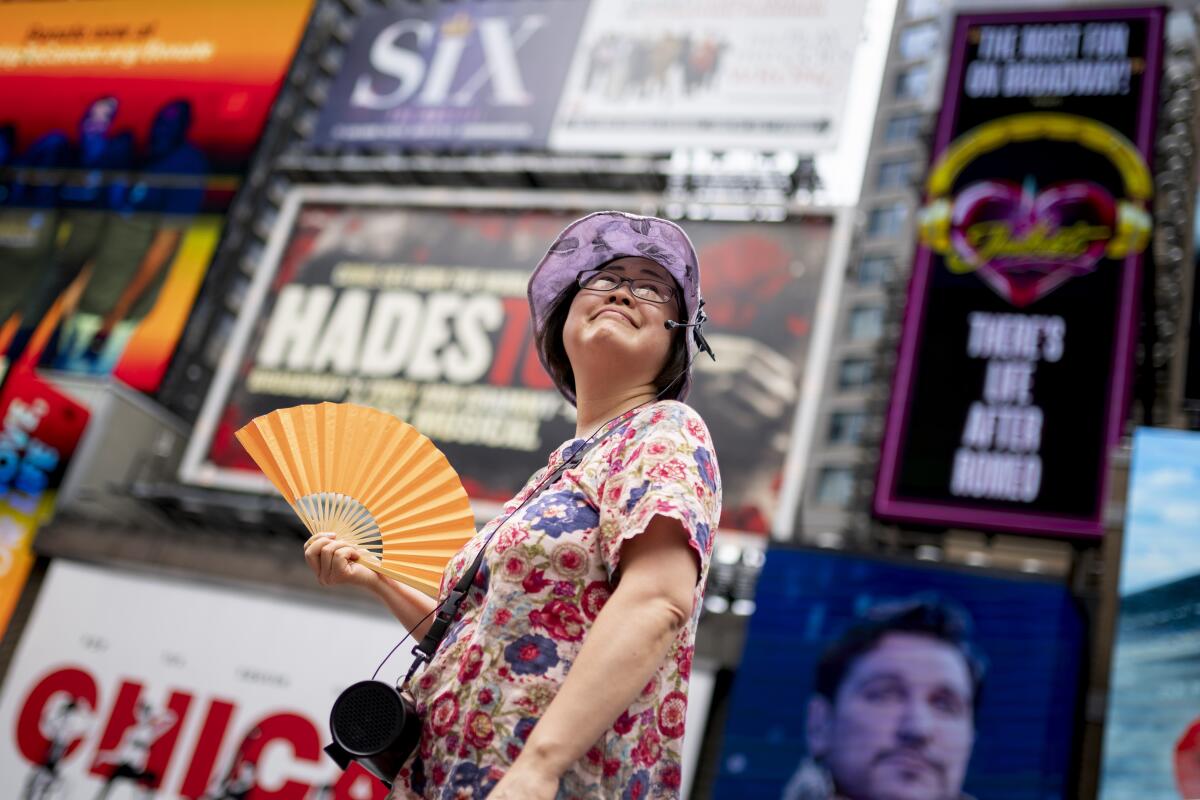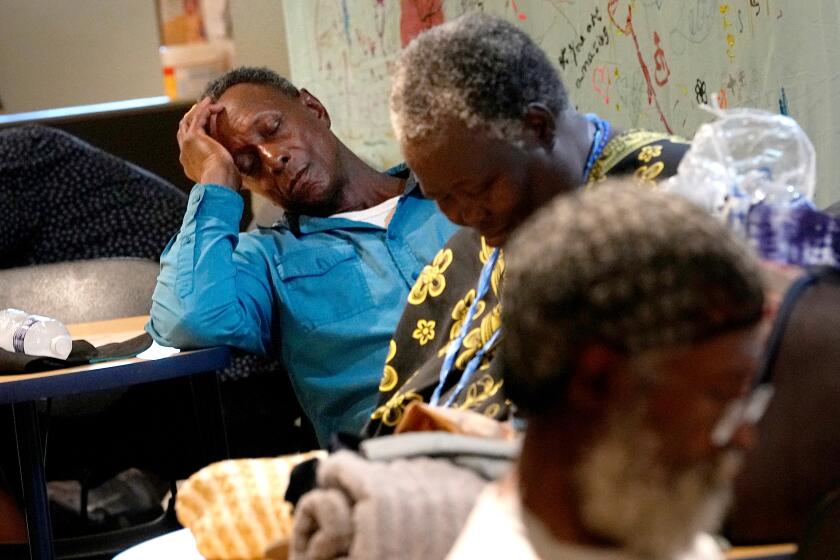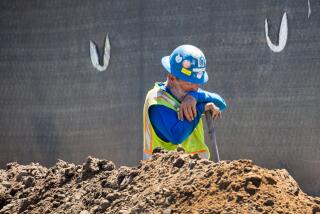Extreme heat moves east, where many will see their hottest days of the year

- Share via
Nearly 200 million people in the United States, or 60% of the U.S. population, are under a heat advisory or flood warning or watch and have been since Thursday, according to the National Weather Service.
Dangerous heat was forecast to “engulf” much of the eastern half of the United States on Friday as extreme temperatures spread from the Midwest into the Northeast and mid-Atlantic, where some residents will see their hottest temperatures of the year.
Although much of the country does not cool much on normal summer nights, night temperatures are forecast to stay hotter than usual, prompting excessive heat warnings from the Plains to the East Coast.
From Thursday to Friday, the number of people under a heat advisory rose from 180 million to 184 million, and the number of people under a flood warning or watch dropped from 17 million to 10 million.
Moisture moving into the Southwest has cooled the southernmost counties of California and parts of southern Arizona, but heat warnings remain for much of the region.
Las Vegas and Phoenix have always endured broiling summers, but the scale and duration of this heat wave has brought new levels of misery.
On top of the heat, severe thunderstorms are forecast for multiple regions of the country. Flash flood warnings are predicted for the Great Lakes, the Ohio Valley and west to the mid-Missouri Valley through Saturday morning.
Tornado watches were posted in Wisconsin and New Hampshire, in addition to heat advisories and potential for severe storms.
The prediction for continued excessive heat comes as the World Meteorological Organization and the European Union’s Copernicus Climate Change Service this week declared July the hottest month on record.
Scientists have long warned that climate change, driven by the burning of fossil fuels, by deforestation and by certain agricultural practices will lead to more and prolonged bouts of extreme weather.
On Thursday, heat and humidity in major cities along the East Coast, including Washington, Philadelphia and New York, created “real feel” temperatures above 100 degrees. Forecasters expected several records to be broken Friday, with temperatures 10 to 15 degrees above average.
Record heat. Raging fires. What are the solutions?
Get Boiling Point, our newsletter about climate change, the environment and building a more sustainable California.
You may occasionally receive promotional content from the Los Angeles Times.
The “dangerous” heat wave, as the National Weather Service called it, won’t subside until Sunday. But Bob Oravec, lead forecaster with the service’s Weather Prediction Center, said the hottest temperatures would happen Friday.
“By Sunday, the high temperature is going to be 86,” he said, “so that’s more typical weather you would expect in July.”
The Salvation Army in the Bronx was one of hundreds of cooling centers open in New York City to give people a respite from the scorching heat.
“It’s very hot every year. This year, it started last week, becoming very hot,” said Robert Ciriaco, a corps officer with the Salvation Army. It’s “very dangerous for people. Some people die. So that’s why we open to offer people [a place] to come to be comfortable.”
In the Southwest and southern Plains, oppressive temperatures have been a blanket for weeks. One meteorologist based in New Mexico called the prolonged period of 100-degree-plus temperatures unprecedented.
“They probably aren’t going to have a lot of sympathy for the rest of the country,” Oravec said.
Because of the extreme heat, some of the nation’s large power grids and utilities are under stress, which could affect Americans’ ability to cool off.
In New York City, utility Con Edison sent out a text blast asking residents to be frugal with air conditioning to conserve electricity. Overtaxing an electrical grid can mean blackouts, which are not just an inconvenience but can lead to equipment failures and major pollution as equipment restarts.
The country’s largest power grid, PJM Interconnection, declared a Level 1 energy emergency alert for its 13-state grid on Wednesday, meaning the company had concerns about its ability to provide enough electricity.
The extreme heat wave is a worrisome indication of a climate gone haywire as the arrival of El Niño meets with human-caused climate change.
“PJM currently has enough generation to meet forecast demand, but operators continue to monitor the grid conditions for any changes,” said spokesperson Jeffrey Shields on Thursday.
PJM isn’t the only electrical grid to issue such an alert. The Midcontinent Independent System Operator, which covers states mostly in the Midwest and northern Plains, issued a similar one Thursday.
The California Independent System Operator also issued an energy emergency alert for Wednesday evening, in part due to excess heat in Southern California, but that expired the same day. Anne Gonzales, a CAISO spokesperson, said the utility expects to be able to meet demand the next few days.
Death Valley temperatures soared to 128 degrees Sunday, breaking the daily record of 127 degrees set in 2005 and 1972. It was expected to hit 125 on Monday.
A spokesperson for the Electric Reliability Council of Texas, which covers most of Texas, said it expects its grid to operate as usual usual during this latest blast of extreme weather across the country.
The dangerous heat will peak in the Northeast, mid-Atlantic and Midwest on Friday and Saturday before a cold front is expected to bring some relief Sunday and into next week.
Heat experts and environmental advocates said the effects of the high temperatures will not be felt equally.
“The impacts of heat are highly inequitable,” said Ladd Keith, an assistant professor at the University of Arizona who studies heat policy and governance. He explained that people experiencing homelessness feel heat effects more than the housed, and low-income residents and communities of color are often hotter than more affluent and whiter neighborhoods.
“When we’re talking about how to keep people safe, we not only need to be thinking about the neighborhoods that are disproportionately warmer during these heat waves,” said Jeremy Hoffman, director of climate justice and impact at Groundwork USA, an environmental justice nonprofit. “But [also] the folks that can’t avoid being outside during these heat waves, people that rely on public transportation, people that work outside, and the extremely elderly that may be living in substandard housing without a lot of ventilation and air conditioning.”
More to Read
Sign up for Essential California
The most important California stories and recommendations in your inbox every morning.
You may occasionally receive promotional content from the Los Angeles Times.
















